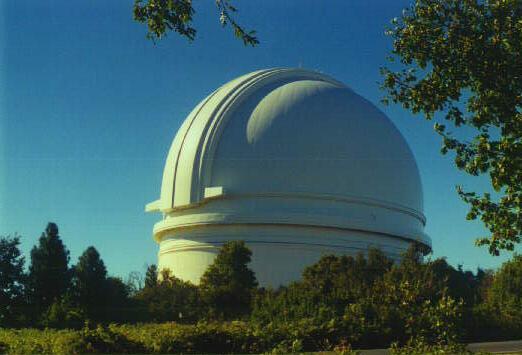
Most professional telescopes are located on the tops of mountains. There are three reasons why this practice is done. First, the tops of mountains are generally located far from cities, where light pollution washes out much of the sky. Second, the higher you can get above sea level, the less atmosphere you have to look through. Finally, the likelihood of cloudy nights is also lessened if your telescope is above the clouds. In addition, most professional telescopes use polished mirrors as the objective (verses a lens), because they are much cheaper to build. So what does that say about Wisconsin, home of the largest refracting telescope in the world and only about 700 feet above sea level? The Yerkes Observatory is located on Williams Bay (Lake Geneva), Wisconsin and was built in 1897. Its 40" diameter lens was placed there because wealthy Chicago industrialist, Charles Tyson Yerkes wanted it there! OK, it says more about Illinois than it does Wisconsin.
For decades the largest and best telescope was the 200" (5 meter) Hale telescope on Mount Palomar, CA

Courtesy Mike Cressy at http://www.4saleusa.net/kscaa/mikeindex.html
The 200" Hale telescope
The 100-inch Hooker telescope at Mount Wilson, California was the largest in the world for 30 years until the Hale telescope (California) was completed in 1949. The one-piece, 200 inch (5.1 meter) diameter massive mirror took several years to polish, but once in place, reigned supreme in the world of telescopes for over 40 years.
In 1974, the Special Astrophysical Observatory, near Zelenchukskaya, Russia introduced a telescope with a single 6 meter diameter mirror. This massive mirror proved to be too massive. The mirror (which was suppose to remain rigid) actually sagged under its own weight as it was tilted to varying degrees. The mirror was eventually replaced with another one in 1979, but it was clear that if future telescopes were to get bigger, they had to be done with a different technique.
In 1993, ground based optical telescopes reached another milestone when the Keck Observatory, on Mauna Kea, Hawaii was put in operation. This telescope consisted of 36 individual hexagonally shaped mirrors which, together, collected the same amount of light as a single 10 meter diameter mirror. Since each individual mirror required much less support, the total weight of the entire system was reduced dramatically. This system worked so well that in 1996, Keck 2 (a twin) was placed in operation on the same mountain.
The segmented mirror design
The concept of single rigid mirrors is not dead. Engineers have developed revolutionary techniques to construct large, light weight, single mirrors using a method known as "spin casting". Basically, molten glass slowly cools in a spinning chamber. The centripetal forces allow the glass surface to obtain a parabolic shape. The Steward Observatory already holds a 6.5 meter diameter mirror and the Large Binocular Telescope (LBT) holds two 8.4 meter diameter mirrors cast using this technique.
Currently, the two 8.4 meter mirrors in the LBT offers the equivalent of a single mirror 11.8 meters in diameter. It is currently being fitted for adaptive optics (see below).
Liquid Mirror Telescopes - The concept of "spin casting" can be taken in another direction. Instead of casing a mirror in glass, use liquid mercury and achieve the parabolic shape by constantly spinning the system at a uniform speed. Light from the sky is directed to the horizontal liquid by a system of mirrors. The first big test was the LZT (Large Zenith Telescope) near Vancouver, Canada in 1994. This 6 meter mirror may prove itself in the coming years.
The thought of a thin flexible mirror was science fiction just a few years ago, but with the advent of high speed computers, it is now a reality. The shape of the mirror is adjusted by several actuators which support the mirror from behind, but why would you do this in the first place?
Our atmosphere is constantly refracting light rays from space in chaotic, random directions. It is the main reason why we see stars twinkle (which astronomers call scintillation). This constant atmospheric turbulence greatly reduced the resolution of ground based telescopes. Placing a telescope on a mountain certainly reduces this effect, but there is really nothing you can do about the weather .. or is there?
If you wear eyeglasses or contact lenses, you are correcting for errors in the way your eyes refract light. Every year or so your eyes may change, ... meaning a new prescription is needed for your glasses. As long as the current state of your eye's lens is completely known, your ophthalmologist will be able to compensate for it with the correct glasses. Wouldn't it be great if we could do the same thing with our atmosphere? We can!
President Reagan initiated a national defense program known as Star Wars in 1984. The idea was to shoot down incoming missiles with lasers or particle weapons. In order to target the missiles, it was first necessary to learn their exact position. Physicists, working in top secret, realized that the atmosphere would refract the visual image of any missile ... meaning it may not physically be where it appears. Using various techniques they could gather data about the condition of the atmosphere at any moment in time, and then compensate for it when aiming their weapon. When this information became declassified, astronomers realized that they could use these same ideas to correct for atmospheric distortion in telescopic images. High speed computers and flexible mirrors work together as meteorologists monitor the atmosphere, send the data to a computer, ... which determines how to adjust the shape of the mirror to make the appropriate visual corrections. This actually sounds like something out of the a Sci-Fi movie, ... but it works! This method is known as adaptive optics, and is currently used in several large telescopes, including the 8.3 meter diameter mirror in the Subaru Adaptive Optics telescope on Mauna Kea, Hawaii. This method now produces ground based telescopic images which exceed the resolution of Hubble Space Telescope.
The Large Binocular Telescope's two 8.4 meter mirrors give a equivalent of a single 11.8 meter mirror. The mirrors employ adaptive optics and interferometry (see below). This optical telescope in Arizona was fully operational in 2008.
The TMT (Thirty Meter Telescope) project is in limbo. In 2011, the planners picked Mauna Kea as the site of this mammoth scope which will use segmented mirrors and adaptive optics to take the crown as the largest (and best) telescope in the world but plans have been stalled since the proposed site was declared sacred to Native Hawaiian culture.
The Giant Magellan Telescope will use segmented mirrors which yield the light collecting equivalent of a single 24.5 meter diameter mirror. Set for operation in 2022, this system (in Chile) will produce images with a resolution 10 times better than the Hubble Space Telescope.
The European Extremely Large Telescope is set for operation in 2024. The E-ELT (Chile) will use several segmented, flexible mirrors with a total collecting area of a single mirror 39 meters in diameter!!!
Any other new ideas in telescope design? It gets even stranger, ... but not right now.
Ever since the advent of computers, astronomers have opened another window to the universe in the form of radio telescopes. Radio waves penetrate our atmosphere almost unhindered, failing to reach the surface only when it rains. You may even own a "dish" which delivers your TV or internet to your home via radio waves.
|
courtesy NASA |
Hey, I have a radio telescope too! |
|
|
radio images from space, courtesy NASA |
Good News - Radio astronomers actually enjoy several advantages over optical astronomers (imaging in the visible portion of the spectrum). These advantages are:
A radio telescope can collect data nearly all the time,
including during the day and even when it is cloudy. Rain, however, will
interfere with the signal.
Radio waves penetrate the dust found in space. If an
interesting object is surrounded by lots of space dust, nothing will appear in
an image taken in the visible section of the electromagnetic spectrum. Radio astronomers are needed to "see"
beyond this veil, often revealing very interesting objects.
Recall that all solids above absolute zero will radiate energy into space (see blackbody curves and Wien's Law in a previous unit). An object's temperature determines which section in the electromagnetic spectrum it emits most of its radiation. Stars, which are relatively hot, radiate mostly in the infrared, visible, and UV. Deep space is, however, very cold (close to absolute zero). Cold space still radiates electromagnetic energy into space, but only in the radio portion of the spectrum. If you want to discover the cold universe, you will have to ask a radio astronomer.
Bad News - If you were a radio astronomer working in the 1960's, you also had a big problem. If you recall:
 .... the smaller the value for R, the sharper the image.
.... the smaller the value for R, the sharper the image.
This means that radio waves (which have a very long wavelength) produced very blurry images, ... even with the largest radio telescopes on the earth. Basically, radio astronomers knew there were lots of interesting radio sources in space, they just couldn't see them very well (like trying to look through a bathroom window).
Good News - One way to lower the resolution angle (R) is to increase the diameter of the objective (D). It was impractical to make radio telescopes much bigger than they already were, but there was a better idea - arraying. Arraying (also known as interferometry) is a technique where two (or more) separate radio telescopes work as one to improve resolution.
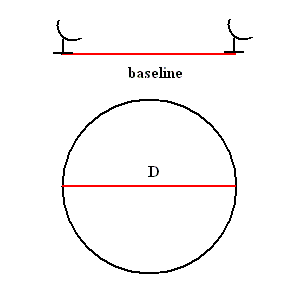
To help you understand this technique, imagine you had one huge radio dish (see diagram above) with an aperture D. This yields a certain resolution angle (R). To achieve the same resolution angle, all you need to do is link two separate (but smaller) radio scopes together and separate them by a distance D. Astronomers refer to the distance between the individual scopes as the baseline. The bigger the baseline, the better the resolution. Of course, the actual technique is incredibly complicated, requiring advanced knowledge of physics and computations by the best computers in the world, ... but does it work?
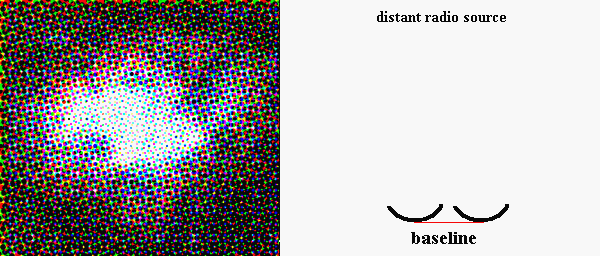
Interferometer (arraying) in this animation.
The first large scale test of this technique was the VLA (Very Large Array) in a desert in New Mexico. This system was dedicated in 1980 and was a remarkable success. In 2010, it was upgraded to improve sensitivity and frequency range and is now called the Expanded VLA or EVLA..
|
VLA Credit NASA |
Credit: F. N. Owen (NRAO) et al., VLA, NRAO, AUI |
Since resolution improves with increased baseline, the next logical step is to move the radio telescopes farther apart. The VLBA (Very Long Baseline Array) was completed in 1993 and consisted of 10 radio telescopes spaced throughout North America.
Credit NRAO
The resolution of this system is incredible. Measured in the milliarc-second range, this value is equivalent to being able to read the print of a newspaper in Wisconsin from Hawaii. Stated a different way, this system is able to identify solar system sized objects at the very center of our Milky Way.
Another system of arrays is currently working in an elevated desert located in Chile. The ALMA array consists of 66 telescopes but operates in the far infrared section of the EM spectrum and is fully operational since 2013. This system will be able to observe exoplanets planets directly. Way cool!
The Event Horizon Telescope has taken radio interferometry to a new level with telescopes located all around the globe. This basically turns the entire planet into one giant telescope. The supermassive black hole in the center of our Milky Way was imaged with this instrument. In 2019, the EHT took this first picture of visible matter around a 6 billion solar mass supermassive black hole in the distant galaxy M87.
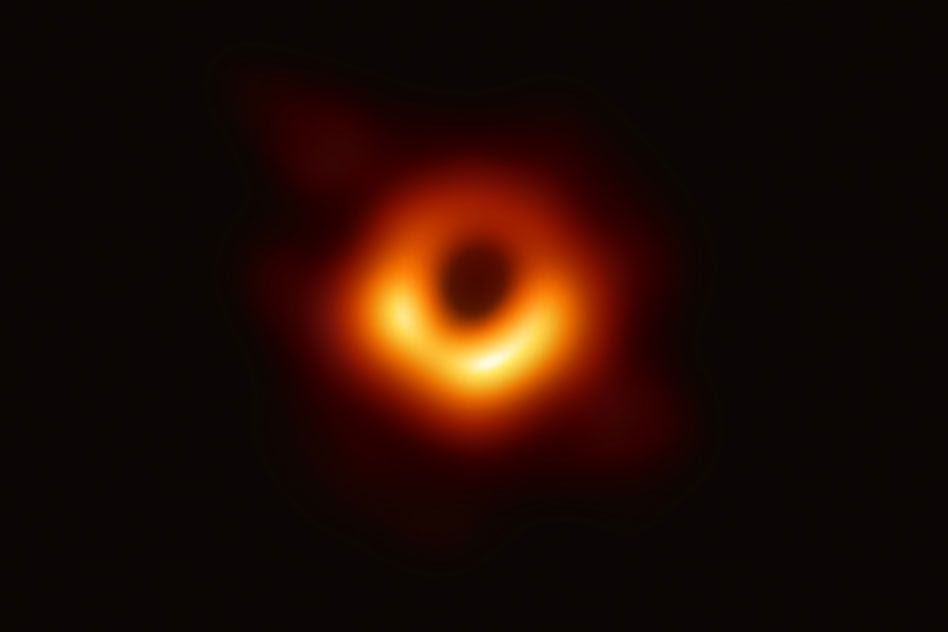
Event Horizon Telescope image of a supermassive black hole in M87
Optical astronomers have now gotten into the act. Interferometers using optical telescopes proved successful so far. The first large scale test came from the VLT (Very Large Telescope) in Chile. This system is fully operational since 2000 and consists of 4 separate telescopes, each 8.2 meters in diameter. This yields the light collecting power of one single 16 meter diameter mirror. In addition, each mirror is equipped with an adaptive optics system (flexible mirrors). The four scopes will work as an array to produce visible images with resolutions equivalent to that already achieved by the VLBA in the radio spectrum. This system rocks!
The reason you would want to place an observatory in space is to escape our turbulent atmosphere, plus the instrument can work 24/7. The most obvious place to put a space observatory is in orbit around the Earth. But it is not the only place. Another place is in a heliocentric orbit. Simply stated, the instrument orbits the sun. There is, yet, another place to put your observatory - a Lagrange (or Lagrangian) Point!
In any system consisting of two masses (such as the Sun and the Earth), there exists 5 Lagrange (or Lagrangian) points. These points can be thought of as "gravity wells" in the system which represent stable points. That is, if gently placed at any of these points, they will remain at these points. Lagrange points are labeled L1, L2, L3, L4, and L5 (see diagram above). Any Lagrange point is a great location to place your space observatory as you will soon see. You can even place a probe (like the Planck probe) around a Lagrange point (called a Lissajous orbit).
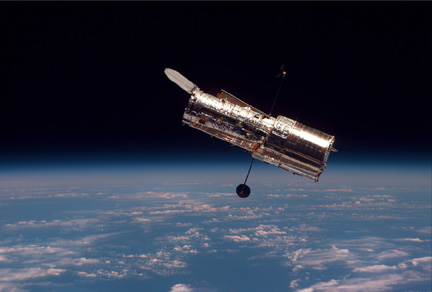
Hubble Space Telescope - Credit NASA
Hubble was launched in 1990 and had a very shaky start. After it was launched, it was discovered that the the primary mirror had a flaw. During the polishing process, a programming error caused the outer sections of the mirror to focus light to a different point than the rest of the mirror. Once discovered, it was corrected by placing a correcting plate in the optical system. Ever since, the taxpayers got their $1.5 billion dollars back, ... with interest. So ingrained in our vocabulary, when NASA announced that it would no longer service the Hubble, a public outcry flooded their email inbox. The future of Hubble is still pending.
Except for visible and radio waves, most of other sections of the electromagnetic radiation suffer major atmospheric absorption. Observing microwaves, infrared, UV, X-Rays, and Gamma rays from space is not a luxury,... it is a necessity. NASA and other international agencies have sent a fleet of orbiters designed to study the sky in all sections of E-M spectrum. Below is a short list of some of the projects.
Gamma Rays - Compton Gamma Ray Observatory was in operation for 9 years studying the "violent universe". It tumbled into the atmosphere and burnt up in 2000, but only after it made a detailed map of gamma ray sources in the sky. It studied highly energetic events including supernova, black holes, and quasars.
X-Rays - Chandra X-Ray Observatory has been in operation since 1999, ... discovering the secrets of the "hot universe".
Ultraviolet - The Ultraviolet Imaging Telescope (UIT) and I have to plug the Wisconsin Ultraviolet Photo-Polarimeter Experiment (WUPPE) ... Go Badgers!
Infrared - Spitzer Space Telescope was launched in 2003 and retired in 2020. Get ready for the next generation infrared version of Hubble .... the James Webb Space Telescope (JWST) scheduled to launch in 2021. It is designed to orbit at Lagrange point L2. This will blow the doors off Hubble (if things go as planned)!!!
Microwaves - The Wilkinson Microwave Anisotropy Probe (WMAP) launched in 2001 and resided at Lagrange Point L2 until 2010 (and later moved to a heliocentric orbit), and studied the cosmic background radiation from space. It is the follow-up to the Cosmic Background Explorer (COBE), a 1992 mission to map details about the very early universe.
Studying the Sun - Solar & Heliospheric Observatory (SOHO) is a joint venture by NASA and the European Space Agency (ESA) to study the sun at all wavelengths of the E-M spectrum. Launched in 1995, SOHO can provide us with advanced warnings whenever the sun emits harmful radiation and/or cosmic rays towards earth. SOHO orbits at Lagrange Point (L1) which keeps it between the earth and the sun at all times. Another project - STEREO: (Solar TErrestrial RElations Observatory) was launched in 2006. This actually consists of two probes (Placed in Lagrange points L4 & L5) to produce a 3D image of the sun. Finally, the Solar Dynamics Observatory (SDO) launched in 2010. Its mission is to study the variability of the sun (magnetic field, solar wind, etc.) and how those changes may affect the Earth.
Neutrino detectors - A neutrino is a sub-atomic particle which is often a byproduct of nuclear reactions and other "high energy" events. Once made, a neutrino moves from its source at high speeds with virtually no interactions with ordinary matter. Neutrinos are manufactured in the core of the sun, but unlike the radiation which is also created there, the neutrinos get to the earth about 8˝ minutes after they are created. Theoretically, neutrinos are also manufactured in great numbers during stellar explosions known as supernovae. One controversial hypothesis even contends that the earth may have a small nuclear reactor at its core. To test our current theories, we need to be able to measure accurately the type, number, and direction of incoming neutrinos from space (or even the core of the earth). Three huge neutrino detectors will help answer these questions:
The Sudbury Neutrino Observatory (SNO) is in Sudbury, Canada
Super-Kamiokande is a neutrino detector located in the Kamioka Mozumi mine in Japan.
AMANDA II project in Antarctica
Cosmic Rays - As mentioned earlier, cosmic rays are high speed particles (mostly protons) which reach the earth from the sun, supernovae, and other high energy cosmic events. The Pierre Auger Observatory in Argentina and the SLAC Cosmic Ray Detector hosted at Stanford University may unveil the many secrets of these phenomena.
Gravity Waves - When stars explode or neutron stars collide, theory predicts ripples in gravity ... which means we need gravity wave detectors to measure them. The Laser Interferometer Gravitational Wave Observatory (LIGO), a system located in Washington State and Louisiana, is up and ready to take data. The great news is LIGO finally detected the first tiny ripple in the fabric in space-time in 2015. Gravitational waves exist and further confirm Einstein's Theory of Relativity.
Miscellaneous
Kepler Mission - Launched in March 2009, this mission is to discover earth like planets in the "habitable zone" using transits. If the alignment is just right, it is possible to detect a planet as it passes between us and the star it orbits. During the transit, there will be a very slight dip in the brightness. Kepler simultaneously observed 100,000 stars simultaneously for patterns of light change. When a dip in brightness occurs in a regular pattern, it is because a planet is orbiting around it. Just look at this list for all the planets named Kepler. Launched in 2018, TESS (Transiting Exoplanet Survey Satellite) is the follow-up to Kepler and doing its thing right now. This probe will survey over 500,000 stars for exoplanets using the transit method .... looking for "Earth like" planets in the "habitable zone".
Large Synoptic Survey Telescope (LSST) - Scheduled for operation in 2019, this 8.4 meter telescope will make wide field surveys to look for anything that changes. This can discover approaching killer asteroids, new Kuiper belt objects, distant supernovae, and locations of dark matter. Basically it can survey the entire night sky in 3 days by taking individual 30 second exposures and then moving to a new location. It then compares each 30 second image with images it has taken previously to look for anything that changes.
ŠJim Mihal 2004, 2014, 2017, 2020 - all rights reserved